Key takeaways:
- Gender equality advocacy focuses on dismantling systemic barriers and acknowledging intersectionality among marginalized groups.
- Transgender representation in the workplace is crucial for creating an inclusive environment and empowering individuals and communities.
- Challenges faced by transgender professionals include misgendering, discrimination during hiring, and lack of support networks.
- Building supportive networks and effective advocacy through storytelling, training, and collaboration with allies are essential for fostering inclusivity.

Understanding gender equality advocacy
Gender equality advocacy is more than just a concept; it’s a movement fueled by the collective desire for fairness and respect across all gender identities. I remember the first time I attended a gender equality workshop. The energy in the room was palpable, filled with individuals who shared their stories and struggles. It made me realize how crucial it is for everyone to have a voice in this conversation, regardless of their background.
As I navigated my journey as a transgender professional, I often pondered, what does true equality mean? For me, it means dismantling systemic barriers while recognizing the unique experiences of marginalized groups. Acknowledging the intersectionality of gender, race, and socioeconomic status is pivotal. It deepened my understanding of the challenges that many face, and it drives me to advocate for inclusive policies that truly represent diverse needs.
One powerful aspect of gender equality advocacy is its ability to foster community and support. I vividly recall a moment of connection with a fellow advocate who shared her story of discrimination in the workplace. It struck me how shared experiences can unite us and motivate action. These connections remind us that our advocacy is not just a task; it’s a heartfelt commitment to creating a world where everyone can thrive without prejudice or fear.
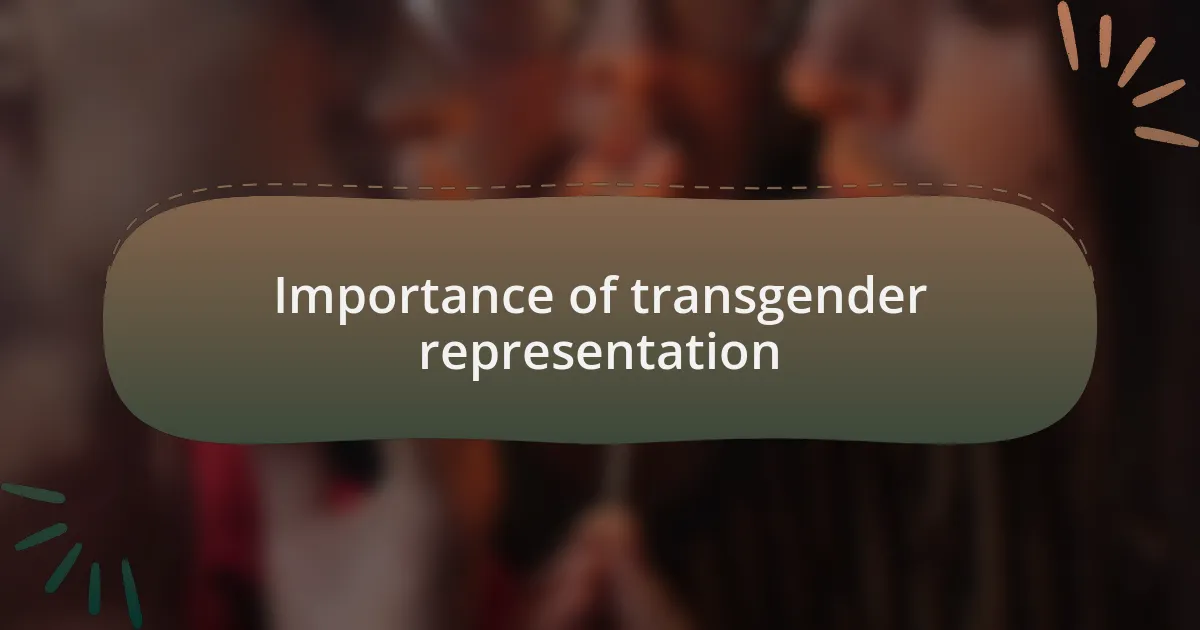
Importance of transgender representation
Transgender representation in the workplace is incredibly vital. When I first started my career, I often felt invisible, grappling with the uncertainty of whether my identity would be accepted. I remember how uplifting it was to see a transgender colleague in a leadership role; their presence created a sense of possibility and encouraged me to be my authentic self. It’s truly inspiring to see that representation can empower not just individuals but entire communities.
When organizations prioritize transgender representation, they send a clear message about inclusivity and respect. I once attended a company meeting where the leadership team actively discussed strategies to support transgender employees. That moment captivated me; I realized how powerful it is when those in positions of power recognize the necessity of diverse voices. It’s a reminder that representation is not just about numbers; it’s about cultivating an environment where everyone thrives.
The impact of seeing transgender individuals in various roles extends beyond the workplace, influencing societal perceptions as a whole. I often reflect on how my experiences have shaped my understanding of identity and validation. I ask myself, why should anyone have to conceal their true self? Visibility in professional spheres not only benefits those who are representative but also fosters a culture of empathy and understanding for everyone.
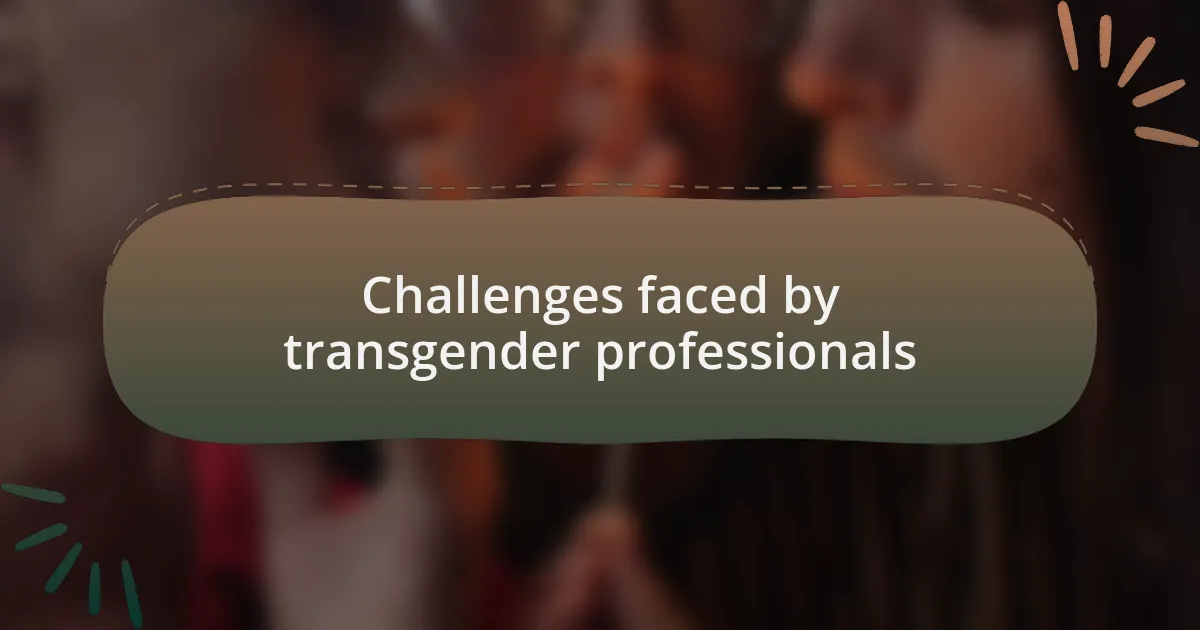
Challenges faced by transgender professionals
Navigating the workplace as a transgender professional can be fraught with challenges that often feel deeply personal. For instance, I remember a time when I faced misgendering from a colleague during a team project. Each time it happened, it felt like a reminder of the struggle for recognition and respect, reinforcing how critical it is for organizations to implement proper training on gender sensitivity.
Another significant hurdle is the fear of discrimination during hiring processes. There was a point when I hesitated to apply for a job that I was highly qualified for, worried that my identity might overshadow my capabilities. From my experience, this anxiety is not uncommon; many transgender individuals may worry that potential employers will focus more on their gender identity than their professional qualifications, creating an unnecessary barrier at the very start of their careers.
Moreover, the lack of support networks in some workplaces can be isolating. I have found solace in connecting with other transgender professionals who share similar experiences, but not everyone has that opportunity. How can we create a stronger support system for transgender individuals at work? Open dialogue and mentorship programs are essential for fostering an inclusive atmosphere, allowing us all to feel seen and heard in our professional journeys.
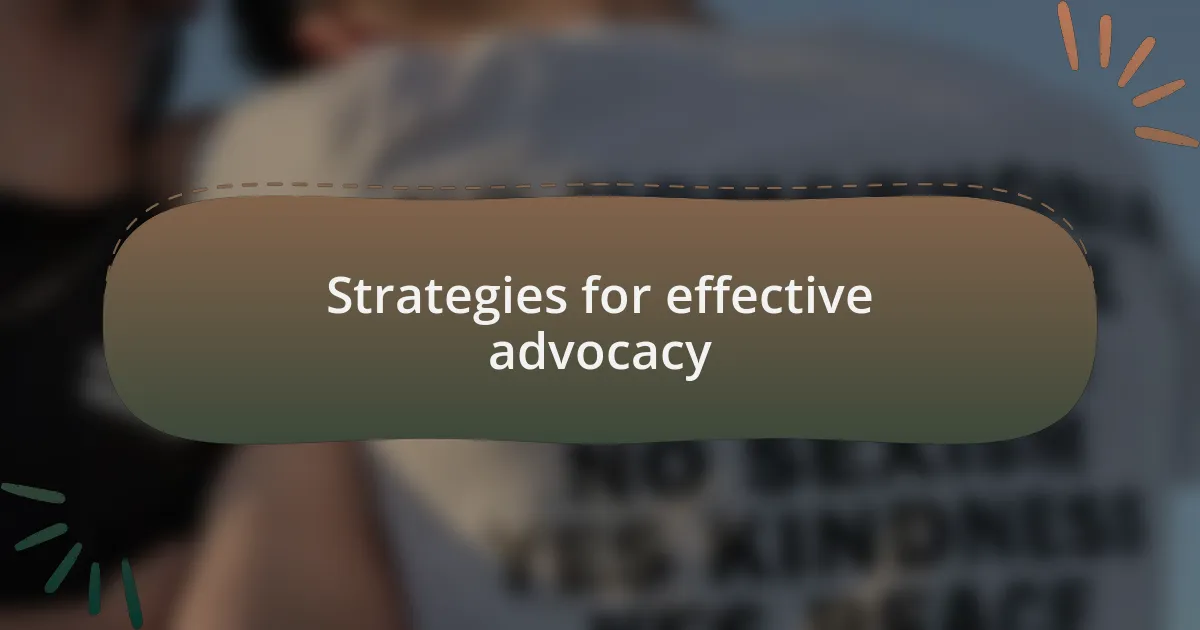
Strategies for effective advocacy
Advocacy for transgender professionals requires a multifaceted approach. From my perspective, sharing personal stories can be transformative. I remember participating in a panel where I shared my journey and the impact of being my authentic self in the workplace. It was eye-opening to witness how my experience resonated with others, creating a shared understanding that fosters empathy and drives change.
One effective strategy I’ve seen is the implementation of comprehensive training programs. These programs should not only cover basic gender sensitivity but also delve into the complexities of transgender issues. I once facilitated a workshop where participants engaged in role-playing scenarios, which helped them grasp the nuances of confronting misconceptions. This interactive approach seemed to spark genuine conversations and prompted real shifts in attitudes.
Building coalitions with allies can amplify advocacy efforts significantly. I distinctly recall partnering with a group of supportive colleagues to launch a diversity committee in my organization. Our collective voices propelled inclusive policies forward, showcasing that when allies stand together with marginalized groups, the impact can be profound. So, how do we cultivate these alliances? It begins with initiating dialogues that invite inclusiveness, paving the way for collaboration and shared advocacy missions.
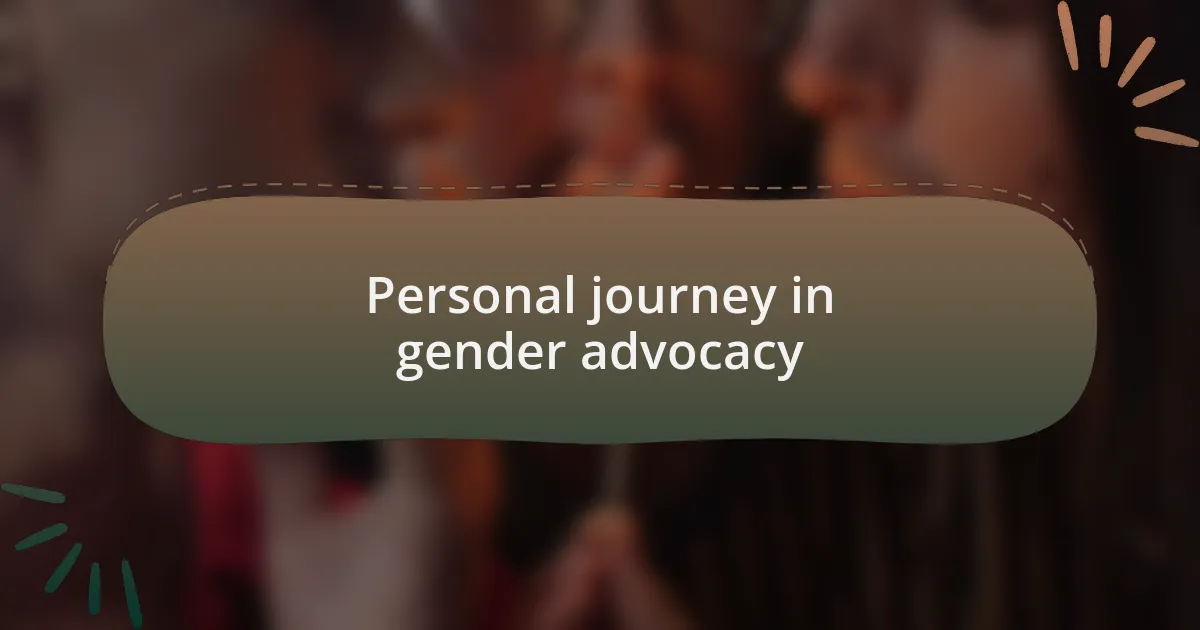
Personal journey in gender advocacy
Everyone has a journey, and mine in gender advocacy has been both challenging and rewarding. I remember the moment I first encountered resistance when trying to advocate for inclusive policies at work. I felt a mix of frustration and determination—frustration at the ignorance but determination to educate. Each setback only fueled my passion to push forward, reminding me that advocacy is often a marathon, not a sprint.
One pivotal experience was attending a conference focused on transgender rights, where I met inspiring advocates who had been in the fight much longer than I had. Listening to their stories, I was overcome with emotion. It was a powerful reminder of the importance of connection, and I realized that my voice could contribute to a larger chorus calling for change. How much of our strength lies in our shared experiences? For me, it became clear that vulnerability breeds resilience, and together we can spark change.
As I dove deeper into advocacy work, I made it a point to engage with younger transgender professionals. I recall a heartfelt conversation with a young trans woman who felt lost in her career due to lack of support. Listening to her fears and aspirations was a transformative moment for me. It reaffirmed my belief that advocacy is not just about policy but about uplifting each other and creating an environment where everyone feels valued. How can we create that supportive space if not by sharing our knowledge and experiences? That realization has driven me to mentor others, committed to ensuring that our collective future is brighter.
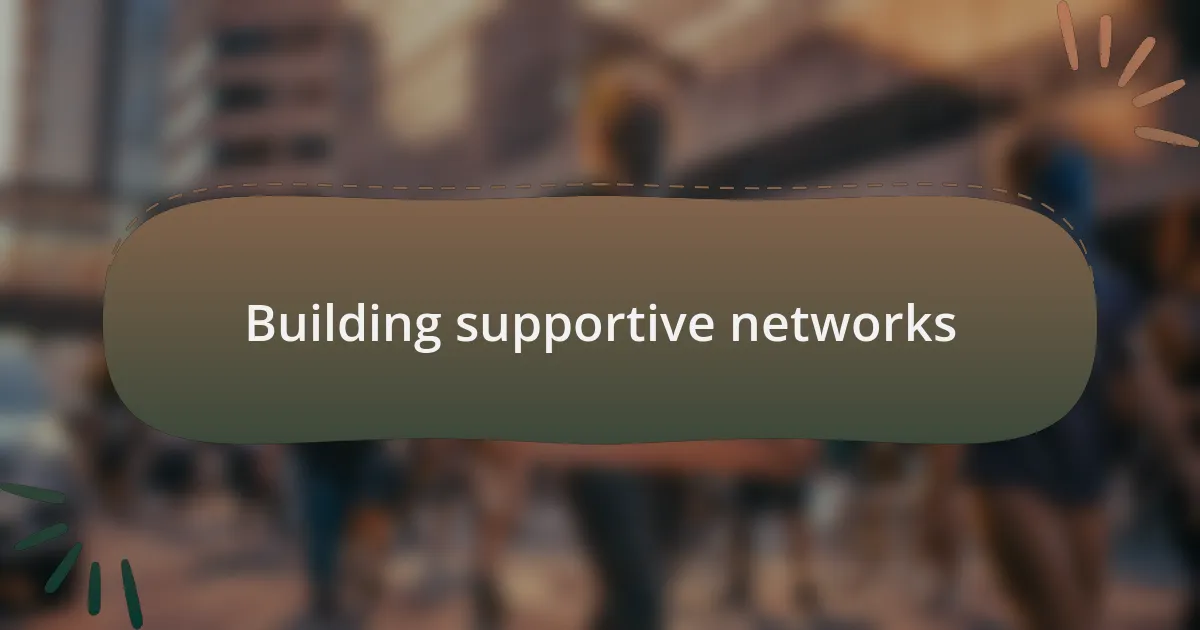
Building supportive networks
Building supportive networks has been a transformative aspect of my journey. Early on, I found a circle of colleagues who not only shared my passions but also understood the unique struggles we face. I recall a late-night conversation where we brainstormed ways to amplify our voices within our organization. That moment reinforced my belief in the power of collaboration; we are undeniably stronger together.
One of my most rewarding experiences came from initiating a peer mentorship group within my professional network. I remember the first meeting, filled with nervous energy as we introduced ourselves and shared our stories. It was profound to witness each individual’s growth as they found their footing and learned to advocate for themselves. Have you ever watched someone’s confidence blossom? There’s something incredibly validating about seeing others rise—it’s a reflection of our collective strength.
Additionally, reaching out to allies has proven crucial in building a robust support system. I vividly remember a conversation I had with a cisgender colleague who offered to help facilitate our training sessions on inclusivity. That open-door policy not only made her a valuable ally but also created a ripple effect, encouraging others to join us. How can we truly advocate for change without the support of those around us? Every connection fuels our mission, proving that networks are vital in fostering an inclusive environment.
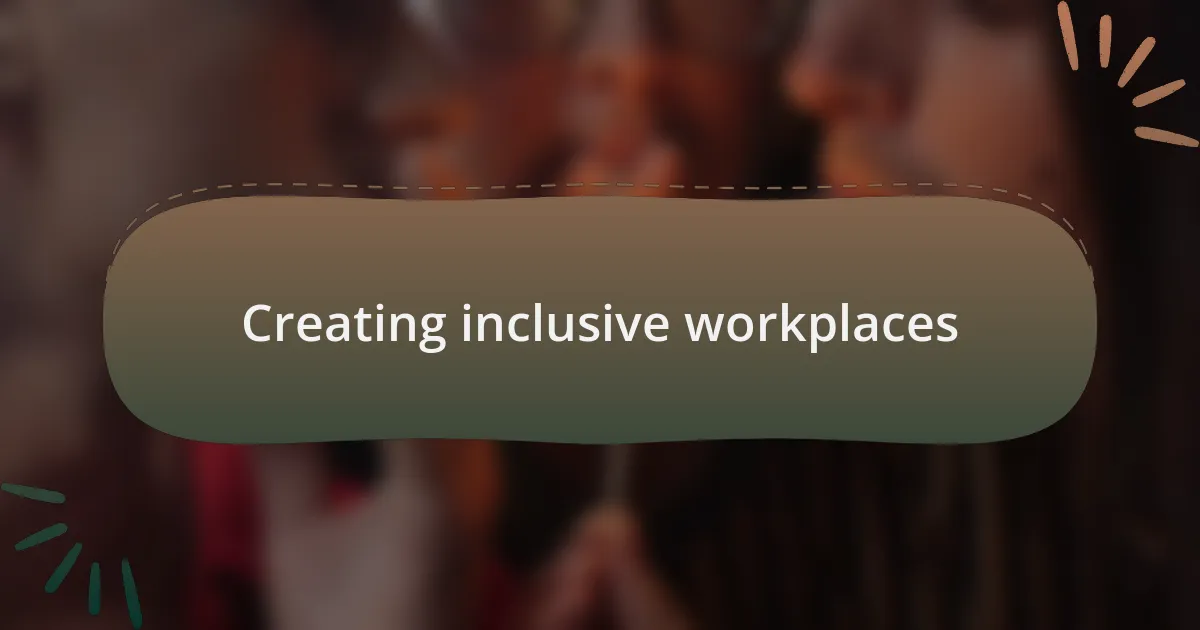
Creating inclusive workplaces
Creating inclusive workplaces starts with understanding the diverse needs of all employees. I once attended a company-wide meeting where our HR leader addressed gender-neutral pronouns. Hearing this acknowledgment made me feel seen and respected in a space that I’d often felt excluded from. Have you ever noticed how a small change in language can open up a completely new space for dialogue? It’s these moments that lay the groundwork for a truly inclusive culture.
To foster an environment where everyone feels valued, regular training on diversity and inclusion is essential. I remember when our team participated in a workshop that highlighted unconscious biases. The discussions that followed were eye-opening; we shared personal experiences and confronted difficult truths. It was a reminder that we each carry blind spots and that learning is a continuous journey. This kind of vulnerability can spark real change—how can we expect progress if we don’t shine a light on these issues?
Moreover, elevating the voices of marginalized individuals is crucial for creating a truly inclusive workplace. I once had the opportunity to lead a panel discussion featuring transgender professionals who shared their journeys. Listening to their experiences not only enriched my understanding but also encouraged others to be more vocal about their own challenges. It made me wonder—what would our workplaces look like if everyone felt empowered to share their stories? By celebrating diverse narratives, we can cultivate an atmosphere of respect and understanding that strengthens our entire organization.